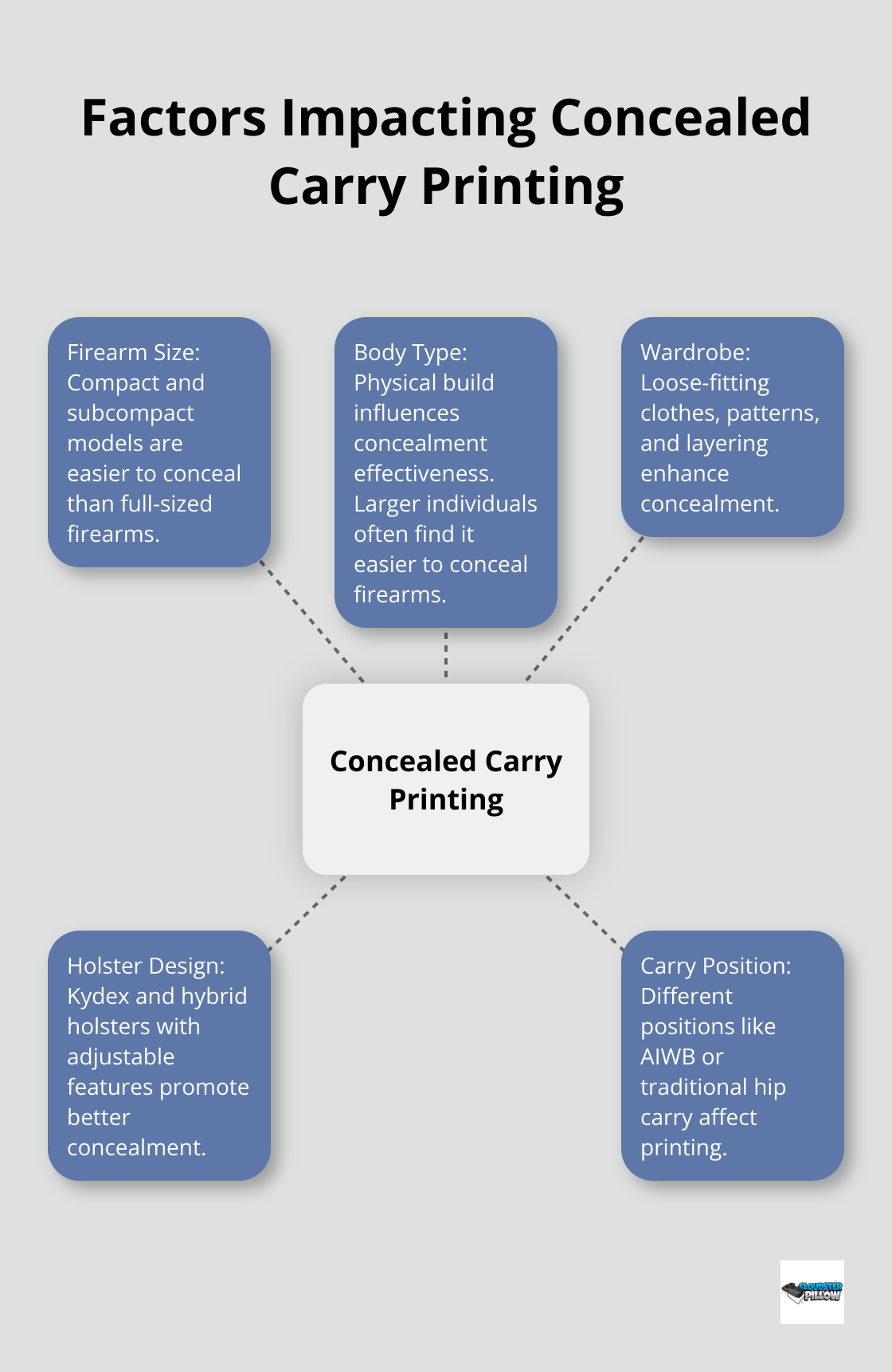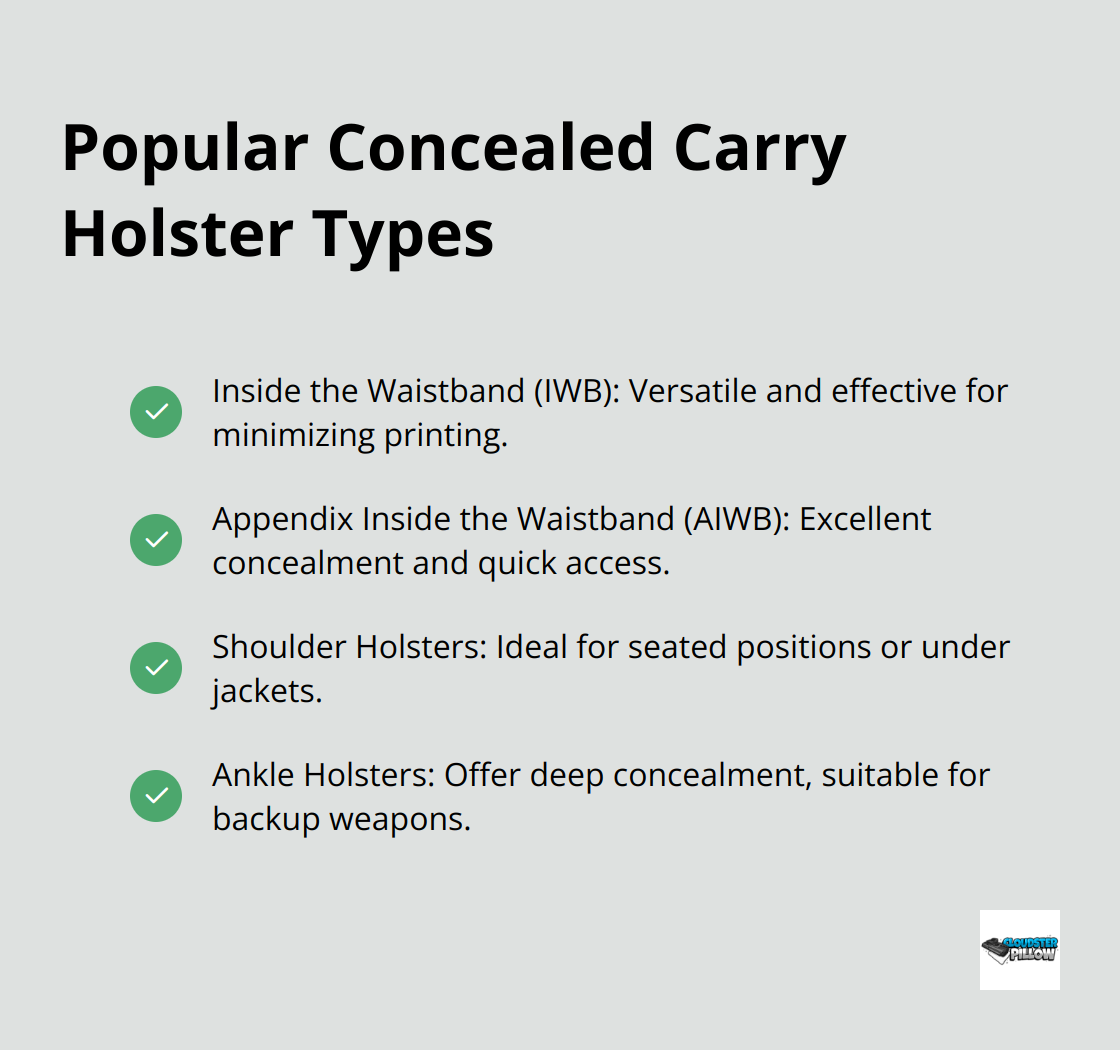Carry Techniques and Optimization
Which Concealed Carry Holster Setup Works Best for Minimal Printing?
Concealed carry holsters are essential for responsible gun ownership, but finding the right setup to minimize printing can be challenging. At Cloudster Pillow, we understand the importance of a comfortable and discreet CCW solution.
In this post, we’ll explore various holster setups that work best for less printing, considering factors like firearm size, body type, and carry position. We’ll also share practical tips and accessories to help you achieve optimal concealment without sacrificing comfort or quick access.
What Impacts Concealed Carry Printing?
Firearm Size Matters
The size and shape of your firearm significantly impact printing. Compact and subcompact models are easier to conceal than full-sized firearms. These smaller guns have less mass and smoother contours, which reduce visible outlines under clothing. However, they often sacrifice capacity and shootability. Each carrier must weigh this trade-off between concealability and firepower carefully.
Your Body Type and Wardrobe Choices
Your physical build and clothing choices play a key role in concealment. Larger individuals often find it easier to conceal firearms, as they have more body mass to work with. This doesn’t mean smaller-framed people can’t carry effectively. It’s about finding the right combination of firearm, holster, and clothing that works for your body type.
Loose-fitting clothes generally conceal better than tight ones. Patterns and textured fabrics are more effective at breaking up the outline of a firearm than solid colors. Layering with lightweight jackets or open shirts adds concealment without bulk. Longer shirts prevent printing when you bend or stretch.
Holster Design is Critical
The design and material of your holster significantly affect printing. Kydex and hybrid leather/polymer holsters reduce shifting and promote a snug fit. Features like adjustable cant and ride height allow you to customize the holster’s position for optimal concealment based on your body type and carry position.
Wedges and claw attachments on holsters help push the grip of the firearm inward, which significantly reduces printing. A holster wedge is a small device that attaches to an IWB holster to reduce printing by lightly pressing against your abdomen to draw the top of your firearm closer to your body. The Cloudster Pillow provides additional comfort and concealment by reducing pressure points, especially for inside-the-waistband and appendix carry setups.
Carry Position Impacts Concealment
Your chosen carry position greatly influences printing. Appendix carry (AIWB) often provides optimal concealment and accessibility for many users. Appendix carry gives you quick and easy access to the firearm because it’s located in an area where you can easily reach it with your dominant hand. Traditional hip carry positions (3-5 o’clock) can work well but require appropriate holsters to prevent protrusion.
Try different positions to find what works best for your body type and daily activities. The most concealable position is useless if it’s not comfortable enough for everyday carry or doesn’t allow quick access in an emergency.

As we move forward, we’ll explore popular concealed carry holster setups that excel at minimizing printing while maintaining comfort and accessibility.
Best Holster Setups for Concealed Carry
Inside the Waistband (IWB) Holsters
IWB holsters top the list for concealed carry due to their versatility and effectiveness in minimizing printing. These holsters sit inside your waistband, keeping your firearm close to your body. A survey by the United States Concealed Carry Association (USCCA) found that 36,085 USCCA members responded, and the results were applied to the total number of Active USCCA members to illustrate the total crimes.
To optimize concealment with an IWB holster, position it between 3 and 5 o’clock on your strong side. This placement allows for a natural draw while hiding the firearm under a loose-fitting shirt or jacket. Many IWB holsters (such as those from Alien Gear or Crossbreed) offer adjustable cant and ride height, which lets you fine-tune the position for your body type and clothing style.
Appendix Inside the Waistband (AIWB) Holsters
AIWB holsters have surged in popularity due to their excellent concealment properties and quick access. Wearers position these holsters at the front of the body, typically between 12 and 2 o’clock. Often referred to as appendix carry (AIWB), this position offers some great advantages, but ignoring its disadvantages may prove dangerous.
When selecting an AIWB holster, look for models with built-in wedges or claws to help tuck the grip of your firearm closer to your body. The Cloudster Pillow excels as an addition to AIWB setups, providing extra comfort and reducing printing by filling the gap between your body and the holster.
Shoulder Holsters
Shoulder holsters provide a unique concealment option, especially for those who spend significant time seated or driving. While less common than waistband holsters, they prove highly effective when worn under a jacket or loose outer garment.
To maximize concealment with a shoulder holster, choose a horizontal draw position rather than vertical. This configuration keeps the firearm closer to your body and reduces printing. Brands like Galco and Andrews Leather Goods offer adjustable shoulder holsters that accommodate various body types and firearm sizes.
Ankle Holsters
Ankle holsters offer deep concealment, making them an excellent choice for backup weapons or situations where other carry methods prove impractical. Richard Mann examines the basics of using an ankle holster for concealed carry and talks about the pros and cons of the carry method.
For effective concealment with an ankle holster, wear loose-fitting pants or boot-cut jeans. Position the holster on the inside of your support-side leg, just above the ankle bone. This placement allows for a smooth draw while seated or kneeling. Try to find ankle holsters with retention straps and padding for added security and comfort during extended wear.

As you explore these holster options, consider how accessories and techniques can further enhance your concealment strategy. The next section will discuss additional methods to reduce printing and improve your overall concealed carry experience.
How to Enhance Concealment and Comfort
Wedges and Claws: Concealment Game-Changers
Holster wedges and claws serve as powerful tools for reducing printing. While both are designed to draw the top of your weapon closer to your body to reduce printing, they work in different ways. A wedge, typically made of foam or rubber, attaches to the bottom of your holster. It creates a slight tilt, which pushes the grip of your firearm closer to your body. This small adjustment can significantly reduce printing, especially for appendix carry.
Claws are rigid attachments that hook behind your belt. They use the belt’s tension to rotate the grip of your firearm inward. This rotation can help reduce printing. When used together, wedges and claws can transform a good concealment setup into an excellent one.
The Right Belt: A Concealed Carry Essential
A proper gun belt stands as the unsung hero of concealed carry. Unlike regular belts, gun belts support the weight of a loaded firearm and distribute it better around your waist. This makes wearing a gun more comfortable and more secure.
Try belts with internal stiffeners, like those from Kore Essentials or Blue Alpha Gear. These belts maintain their shape throughout the day, which prevents your firearm from shifting or printing. A good gun belt also distributes the weight of your firearm more evenly, which reduces fatigue during extended wear.
Strategic Clothing Choices for Optimal Concealment
Your wardrobe plays a pivotal role in concealment. Loose-fitting, patterned shirts act as your allies. They break up the outline of your firearm and create visual noise that masks any subtle printing. Dark colors also tend to conceal better than light ones.
Consider investing in purpose-built concealment clothing. Companies like 5.11 Tactical and Vertx offer shirts and pants designed with concealed carry in mind. These garments often feature reinforced areas to support holsters and strategically placed pockets for quick access.
Layering serves as another effective technique. A light jacket or open button-up shirt over your concealed carry setup can provide an extra layer of concealment without adding bulk. This strategy works particularly well in cooler weather or air-conditioned environments.
The goal is to blend in, not stand out. Avoid tactical-looking clothing that might draw unwanted attention. Instead, opt for everyday attire that allows you to carry discreetly while maintaining a normal appearance.
Comfort Enhancement with Specialized Accessories
For those using inside-the-waistband or appendix holsters, the Cloudster Pillow stands out as an essential accessory. Its design helps to push the grip closer to your body, reducing printing and making your conceal carry more discreet. This versatile accessory improves firearm concealment, making it ideal for discreet carry.
The key to effective concealment lies in experimentation. Find what works best for your body type, firearm, and daily activities. With practice and the right tools, you can achieve a level of concealment and comfort that allows you to carry with confidence in any situation.

FAQs
What type of holster is best for minimizing printing?
Inside-the-waistband (IWB) holsters are generally the most effective at reducing printing because they position the firearm inside the pants, close to the body. Appendix inside-the-waistband (AIWB) holsters also excel, especially when paired with wedges or claws that angle the grip inward. For deep concealment, ankle holsters can work well, while shoulder holsters offer unique advantages under jackets. The right holster depends on your firearm size, clothing style, and body type.
How do wedges and claws help reduce concealed carry printing?
Wedges and claws are add-ons that significantly improve concealment. A wedge pushes the holster slightly outward at the bottom, which tucks the grip of the firearm closer to the body. A claw works by using belt pressure to rotate the grip inward. When combined, these tools reduce the gun’s profile under clothing, making it far less noticeable. Accessories like the Cloudster Pillow wedge provide both comfort and grip tuck, making them especially useful for appendix carry.
Which carry position helps conceal a firearm the most?
Appendix carry (12–2 o’clock) is one of the most effective positions for concealment because it places the firearm in a natural hollow at the front of the body. Strong-side IWB (3–5 o’clock) also conceals well when paired with loose clothing. Shoulder holsters work best under jackets, while ankle holsters are effective for backup guns. Experimenting with positions is key since the most concealable setup must also remain comfortable for all-day wear.
How does clothing choice affect printing?
Clothing can make or break your concealment. Loose, patterned, or textured fabrics help disguise the firearm’s outline better than tight or solid-colored clothing. Dark colors also hide shadows and bulges more effectively. Layering with jackets or open button-up shirts provides extra coverage, while specialized concealed carry clothing adds discreet reinforcement in key areas. The goal is to blend in naturally without drawing attention.
What accessories improve both comfort and concealment?
A sturdy gun belt is essential for stabilizing your holster and preventing sagging. Holster wedges and claws reduce printing while distributing pressure for greater comfort. Sweat guards add a barrier between the firearm and skin, making carry more comfortable in hot climates. For appendix and IWB carry, the Cloudster Pillow stands out by combining cushioning with enhanced concealment, ensuring a secure and discreet carry setup all day.
Final Thoughts
Choosing the right concealed carry holster setup for minimal printing requires careful consideration. Inside-the-waistband (IWB) and appendix inside-the-waistband (AIWB) holsters effectively reduce visible outlines. Shoulder holsters offer unique advantages, while ankle holsters provide deep concealment options.
Personal experimentation helps find the optimal CCW solution. Test different holster setups, carry positions, and accessories to determine what feels most comfortable and secure. Regular practice with your chosen setup will improve your proficiency and confidence in carrying discreetly.
Comfort plays a vital role in effective concealed carry. Accessories like the Cloudster Pillow can enhance comfort and reduce printing (especially for IWB and AIWB carry methods). This versatile accessory pushes the firearm closer to your body, improving concealment while providing cushioning against pressure points.


Pingback: Concealed Carry Printing: How to Stop It and Carry Confidently
Pingback: Ankle Holsters A Discreet Carry Option - Cloudster Pillow
Pingback: How to Avoid CCW Printing When Carrying Concealed